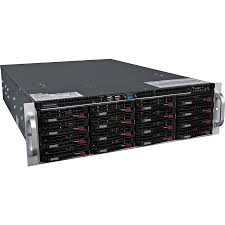Introduction to Gateways
In the rapidly evolving world of IT hardware and networking, gateways are pivotal in facilitating communication between different networks. These devices or software systems act as translators, interpreters, and sometimes guardians of data, ensuring smooth data transmission across varying protocols and architectures. As businesses and individuals alike depend on interconnected devices for efficiency, understanding the role of gateways in modern computing is essential.
What is a Gateway in Networking?
In simple terms, a gateway is a device or program that connects two distinct networks, enabling them to communicate despite differences in protocols, formats, or architectures. It works as a bridge, ensuring seamless data transfer between systems that might otherwise be incompatible.
Unlike routers or switches, which operate within a single protocol, gateways often perform protocol conversion, making them critical in computer hardware setups for complex systems. For instance, a gateway can enable communication between an office’s intranet and external internet services.
Types of Gateways
Gateways come in various forms, each designed to fulfill specific roles in networking environments:
-
Network Gateways
These are the most common type of gateways, connecting two or more networks. A network gateway facilitates data exchange between devices using different IP addressing schemes or communication protocols, such as IPv4 and IPv6. -
Protocol Gateways
These gateways convert data between different protocols, enabling devices that use unique communication standards to work together. For example, a protocol gateway might translate between MQTT (Message Queuing Telemetry Transport) used in IoT devices and HTTP used by web applications. -
Cloud Gateways
As organizations migrate to cloud computing, cloud gateways allow on-premises systems to interact seamlessly with cloud services. They ensure secure and efficient communication between local data centers and cloud platforms. -
VoIP Gateways
In telecommunications, VoIP (Voice over IP) gateways convert analog voice signals into digital data for transmission over IP networks, enabling cost-effective and scalable communication systems. -
Application Gateways
Also known as proxy servers, these gateways manage and filter traffic for specific applications, such as web browsers or email clients, often providing added layers of security and performance optimization.
The Role of Gateways in IT Hardware
Gateways play an indispensable role in the realm of IT hardware by acting as intermediaries between disparate systems. They ensure interoperability, a critical requirement for today’s interconnected environments. For example:
- Bridging Legacy Systems: Gateways can connect older hardware or software systems to modern technologies, extending their usability and saving costs.
- Enhancing Security: Acting as a checkpoint, gateways filter incoming and outgoing data to ensure that only authorized traffic flows between networks.
- Enabling IoT Integration: The Internet of Things relies heavily on gateways to connect diverse devices with varying communication protocols to centralized systems.
How Gateways Work
The operation of a gateway can vary depending on its function, but the general process involves:
- Receiving Data: Gateways intercept data packets from one network or device.
- Protocol Conversion: If necessary, the gateway translates the data into a format compatible with the destination network.
- Routing Data: The converted data is transmitted to the target system or device.
- Security Screening: Many gateways incorporate security measures such as firewalls, encryption, and intrusion detection systems to safeguard the communication process.
For instance, in networking, a gateway connecting a local area network (LAN) to the internet would translate private IP addresses into public ones while implementing security policies.
Key Features of Effective Gateways
To function optimally in complex computer hardware and networking environments, a gateway must have several essential features:
-
High Performance
A gateway should handle large volumes of data with minimal latency, especially in high-traffic networks or mission-critical applications. -
Scalability
As networks grow, gateways must adapt to handle increased data loads and new connections without compromising performance. -
Robust Security
Modern gateways come equipped with advanced security features, including intrusion prevention, malware detection, and data encryption, to mitigate cyber threats. -
Interoperability
Compatibility with a wide range of protocols and devices is a hallmark of a reliable gateway, ensuring seamless communication in diverse IT setups. -
Ease of Management
User-friendly management interfaces and monitoring tools are essential for configuring, troubleshooting, and optimizing gateway performance.
Gateways vs. Routers: Understanding the Difference
While both gateways and routers are integral to networking, their roles differ significantly.
-
Gateways
- Operate at the application layer.
- Translate between different protocols or architectures.
- Handle more complex tasks like protocol conversion and advanced security.
-
Routers
- Operate at the network layer.
- Route data packets within the same protocol.
- Primarily focus on directing traffic based on IP addresses.
For example, a router connects devices within the same network, while a gateway enables communication between two different networks or systems.
Applications of Gateways in Networking
Gateways are indispensable in various scenarios, including:
-
Enterprise Networking
In businesses, gateways connect private networks to public internet services, facilitating secure data exchange with external clients and partners. -
IoT Ecosystems
Gateways bridge communication between IoT devices and centralized systems, translating data formats and ensuring secure data transfer. -
Cloud Integration
Organizations use cloud gateways to connect on-premises IT hardware with cloud platforms, enabling hybrid and multi-cloud environments. -
Telecommunications
VoIP gateways have revolutionized communication by integrating traditional telephony systems with modern IP-based infrastructures.
Challenges and Considerations
While gateways are powerful tools, they come with challenges:
-
Latency
Protocol conversion and data processing can introduce delays, particularly in high-traffic environments. -
Security Risks
As entry points to networks, gateways can become targets for cyberattacks. Implementing robust security measures is crucial. -
Complex Configuration
Setting up and maintaining gateways often requires technical expertise, especially in large-scale IT systems.
To mitigate these challenges, organizations must invest in high-quality gateway solutions and provide proper training for their IT teams.
The Future of Gateways
The role of gateways is evolving alongside advancements in IT hardware and networking. Future trends include:
-
Edge Computing
As edge computing gains traction, gateways will play a crucial role in processing data closer to the source, reducing latency and bandwidth usage. -
AI and Machine Learning Integration
AI-powered gateways will enhance security by detecting and mitigating threats in real time while optimizing data flow based on usage patterns. -
5G Networks
With the advent of 5G, gateways will facilitate faster and more reliable connections for applications such as autonomous vehicles and smart cities. -
Green Networking
Energy-efficient gateways will align with the growing emphasis on sustainability, reducing the environmental impact of IT infrastructure.
Conclusion: Gateways as Cornerstones of Connectivity
In the interconnected world of computer hardware and networking, gateways serve as indispensable components, enabling seamless communication and enhancing interoperability. Whether bridging legacy systems, integrating IoT devices, or securing cloud interactions, gateways are at the heart of modern IT systems.
By understanding their types, functions, and challenges, businesses and individuals can harness the power of gateways to build robust and efficient networks. As technology continues to evolve, gateways will remain a cornerstone of connectivity, driving innovation and shaping the future of communication.




